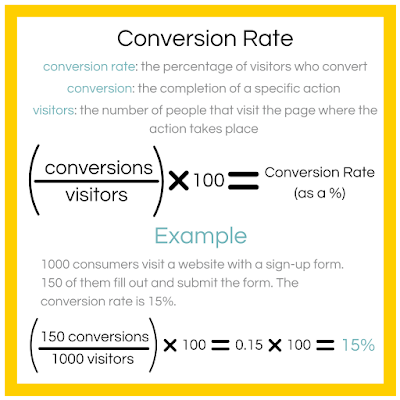You have a newsletter sign-up or an informational form on your website that you want your audience to complete. Or you have products for sale in your e-commerce store that you want your audience to purchase. Every time a member of your audience completes a desired action, you convert them. But how do you know how successfully you are converting viewers?
Conversion rates are a good predictor of success or failure.
What is a conversion rate and how do you calculate it?
Pretend you are staffing a booth at an outdoor market and your goal is to have people fill out an interest form. Some people will come walk by and read some of the information on your signs. Others will stop to talk with you. There will be people who start to fill out the form but leave before they are finished. (Maybe their dog pulled them after a squirrel.) Finally, there will be people who will fill out the interest form. They completed the desired action! You want visitors to your website to convert like the people who visited the outdoor market and filled out the form.
Conversion rate is a percentage of the number of people who visit a particular page and complete a specific action on that page.
For example, 1000 consumers visit a website with a sign-up form. 150 of them fill out and submit the form. The conversion rate is 15%.
Reminder when using analytic tools: it is important to know how the tool classifies visitors. For example, Google Analytics uses the number of sessions in lieu of the number of visitors. This means that someone visit can visit more than once and complete the desired action (Bendle & et al, 2016). This is particularly important when it is an action you want people to complete multiple times like making a purchase.
Which conversion rates are important?
Hotjar states that conversion rates “can tell you how well your website is doing in specific areas you’re interested in” (2021). But you need to define where to focus based on your business goals.
Are you creating awareness about a new product you are offering? Focus on the rate of viewers who clicked from your home page to a product information page.
Are you growing your client list? Look at the rate for your completed newsletter sign-ups.
Do you have an e-commerce store? Track the rate of visitors who make a purchase.
Want to share your e-book? Concentrate on the rate of visitors who complete the download.
There are conversions inside other conversions.
Maybe your new offering is an e-book. You can track the conversion rate to your product information page as well as the conversion rate for the visitors that download the e-book.
Your goals determine what rates are most important to you and your business for a particular time period.
But what is a good conversion rate?
Similar to clickthrough rate, it depends and varies between industries.
Unbounce found that while the average conversion rate for landing pages across industries is 9.7%, the top performers do so well they skew the data. The top percentile has conversion rates of over 25%! “The median conversion rate for all the landing pages [they] analyzed is 3.2%” (Unbounce, n.d.)
So what does this mean?
Most sites fall closer to the median range, but there is potential to reach higher conversion rates. If you improve the effectiveness of a campaign, you create more value for your audience and you will see your conversion rates increase.
References
Bendle, N., Farris, P., Pfeifer, P., & Reibstein, D. (2016). Marketing Metrics: The Manager's Guide to Measuring Marketing Performance (Third ed.). Upper Saddle River, NJ: Pearson Education.
Hotjar. (2021 February 24). Google Analytics goal conversion rate. Hotjar. https://www.hotjar.com/google-analytics/glossary/goal-conversion-rate/.
Unbounce. (n.d.). Conversion Benchmark Report. Unbounce. https://unbounce.com/conversion-benchmark-report/.



Hi Sarah,
ReplyDeleteI really enjoyed your voice you used when writing your blog post! It personal yet professional and just a joy to read. Your graphics were a nice touch to help explain how conversion rates work and in particular the goal and what rate to focus on was helpful to me; it is simple and useful!
Thank you for sharing your knowledge and view with us!
Hi Micah,
DeleteThanks for your comment! I'm glad the graphics resonated with you. As a visual person myself, graphics always help me comprehend a concept and creating them helps to solidify my understanding.
With much gratitude - Sarah